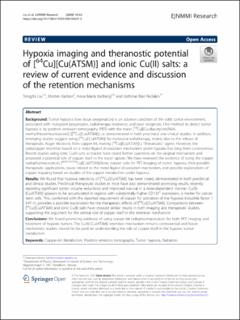| dc.description.abstract | Background
Tumor hypoxia (low tissue oxygenation) is an adverse condition of the solid tumor environment, associated with malignant progression, radiotherapy resistance, and poor prognosis. One method to detect tumor hypoxia is by positron emission tomography (PET) with the tracer [64Cu][Cu-diacetyl-bis(N(4)-methylthiosemicarbazone)] ([64Cu][Cu(ATSM)]), as demonstrated in both preclinical and clinical studies. In addition, emerging studies suggest using [64Cu][Cu(ATSM)] for molecular radiotherapy, mainly due to the release of therapeutic Auger electrons from copper-64, making [64Cu][Cu(ATSM)] a “theranostic” agent. However, the radiocopper retention based on a metal-ligand dissociation mechanism under hypoxia has long been controversial. Recent studies using ionic Cu(II) salts as tracers have raised further questions on the original mechanism and proposed a potential role of copper itself in the tracer uptake. We have reviewed the evidence of using the copper radiopharmaceuticals [60/61/62/64Cu][Cu(ATSM)]/ionic copper salts for PET imaging of tumor hypoxia, their possible therapeutic applications, issues related to the metal-ligand dissociation mechanism, and possible explanations of copper trapping based on studies of the copper metabolism under hypoxia.
Results
We found that hypoxia selectivity of [64Cu][Cu(ATSM)] has been clearly demonstrated in both preclinical and clinical studies. Preclinical therapeutic studies in mice have also demonstrated promising results, recently reporting significant tumor volume reductions and improved survival in a dose-dependent manner. Cu(II)-[Cu(ATSM)] appears to be accumulated in regions with substantially higher CD133+ expression, a marker for cancer stem cells. This, combined with the reported requirement of copper for activation of the hypoxia inducible factor 1 (HIF-1), provides a possible explanation for the therapeutic effects of [64Cu][Cu(ATSM)]. Comparisons between [64Cu][Cu(ATSM)] and ionic Cu(II) salts have showed similar results in both imaging and therapeutic studies, supporting the argument for the central role of copper itself in the retention mechanism.
Conclusions
We found promising evidence of using copper-64 radiopharmaceuticals for both PET imaging and treatment of hypoxic tumors. The Cu(II)-[Cu(ATSM)] retention mechanism remains controversial and future mechanistic studies should be focused on understanding the role of copper itself in the hypoxic tumor metabolism. | en_US |

